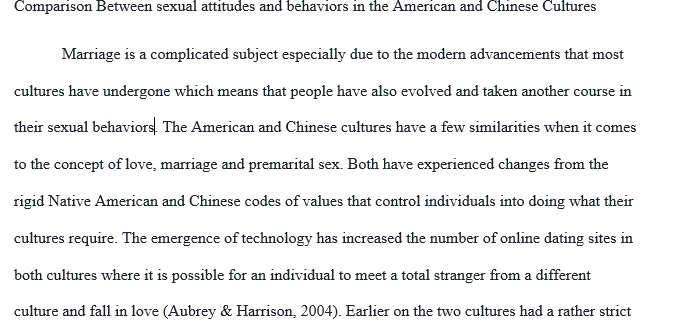For this Assignment, choose one sexual attitude (e.g., monogamy) and one sexual behavior (e.g., chastity, premarital sex). Compare the similarities
For this Assignment, choose one sexual attitude (e.g., monogamy) and one sexual behavior (e.g., chastity, premarital sex). Compare the similarities and differences of these attitudes and behaviours in Chinese and American culture.
In the essay,
1. Compare the similarities and differences of sexual attitude (love or arranged marriage) and behavior (premarital sex) in Chinese and American culture.
2. Describe the cultural factors that influence sexual attitudes and behaviors.
3. Explain how sexual attitudes and behaviors are perceived and displayed within each culture.
- Be specific and provide examples.
- Support your responses using the Learning Resources and the current literature.
READINGS
- Course Text: The Handbook of Culture and Psychology
- Chapter 11, “Gender and Culture”
- Article: Afable-Munsuz, A., & Brindis, C. D. (2006). Acculturation and the sexual and reproductive health of Latino youth in the United States: A literature review. Perspectives on Sexual and Reproductive Health, 38(4), 208–219.
Retrieved from the Walden Library using the Academic Search Complete database.
- Article: Aubrey, J. S., & Harrison, K. (2004). The gender-role content of children’s favorite television programs and its links to their gender-related perceptions. Media Psychology,6(2), 111–146.
Retrieved from the Walden Library using the Communication & Mass Media Complete database.
- Article: Crouter, A. C., Manke, B. A., & McHale, S. M. (1995). The family context of gender intensification in early adolescence. Child Development, 66(2), 317–329.
Retrieved from the Walden Library using the Academic Search Complete database.
- Article: Echávarri, R. A., & Ezcurra, R. (2010). Education and gender bias in the sex ratio at birth: Evidence from India. Demography, 47(1), 249–268.
Retrieved from the Walden Library using the Business Source Complete database.
- Article: Ghule, M., Balaiah, D., & Joshi, B. (2007). Attitude towards premarital sex among rural college youth in Maharashtra, India. Sexuality & Culture, 11(4), 1–17.
Retrieved from the Walden Library using the Academic Search Complete database.
- Article: Lancaster, G., Maitra, P., & Ray, R. (2008). Household expenditure patterns and gender bias: Evidence from selected Indian states. Oxford Development Studies, 36(2), 133–157.
Retrieved from the Walden Library using the Academic Search Complete database. - Article: Miyajima, T. (2008). Gender inequality among Japanese high school teachers: Women teachers’ resistance to gender bias in occupational culture. Journal of Education for Teaching, 34(4), 319–332.
Retrieved from the Walden Library using the Academic Search Complete database.
- Article: Mohammadi, M. R., Mohammad K., Farahani, F. K., Alikhani, S., Zare, M., Tehrani, F.R.,…Alaeddini, F. (2006). Reproductive knowledge, attitudes and behavior among adolescent males in Tehran, Iran. International Family Planning Perspectives, 32(1), 35–44.
Retrieved from the Walden Library using the Academic Search Complete database.
- Article: Para-Mallam, F. J., & Funmi, J. (2010). Promoting gender equality in the context of Nigerian cultural and religious expression: Beyond increasing female access to education. Compare: A Journal of Comparative & International Education, 40(4), 459–477.
Retrieved from the Walden Library using the Educational Research Complete database.
- Article: Sadker, D. (1999). Gender equity: Still knocking at the classroom door. Educational Leadership, 56(7), 22–26. Retrieved from the Walden Library using the Academic Search Complete database.
- Article: Sadker, D., & Zittleman, K. (2005). Gender bias lives, for both sexes. Education Digest, 70(8), 27–30.
Retrieved from the Walden Library using the Academic Search Complete database. - Article: Witt, S. D. (1997). Parental influence on children’s socialization to gender roles. Adolescence, 32(126), 253–259.
Retrieved from the Walden Library using the Medline With Full Text database
gender_role_development an_assessment_of_gender_discrimination_in_household_expenditure_on_education_in_india_ acculturation_and_the_sexual_and_reproductive_health_of_latino_youth_in_the_united_states__a_literature_review_ education_and_gender_bias_in_the_sex_ratio_at_birth__evidence_from_india__ gender_inequality_among_japanese_high_school_teachers__women_teachers__resistance_to_gender_bias_in_occupational_culture
Answer preview
APA
1026 Words
